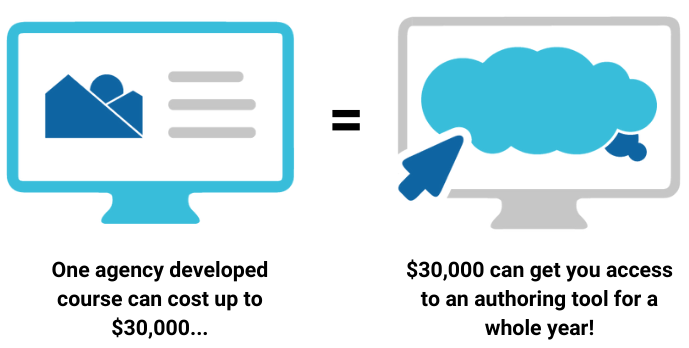How to scale up elearning production capacity to meet demand (without the headache)
7 minute read
Demand for training is growing at a higher rate than ever before. If you and your L&D team are going to keep pace, you need to scale up. But how do you do this while maintaining quality and avoiding the headaches? Find out with our top 7 tips for successful elearning production at scale.

Demand for training is at an all-time high
The accelerated pace of change seen over the last few years has created a number of challenges for businesses. Changing customer expectations, digital transformation, and increased regulation have left all industries facing pressure. And the pace of change contributes to a perfect storm of pain for today’s businesses.
Businesses are increasingly looking to L&D to help them overcome these challenges and keep pace with change. But, with demand for training at an all-time high, and L&D teams reporting they don’t have enough time or people, teams are struggling to keep up.
Faced with a never-ending list of training requests, they’re forced to choose between becoming a bottleneck or allowing quality to slip. Either way, it means employees aren’t getting the effective learning content they need, at the point that they need it. Skill gaps are increasing and, ultimately, the bottom line suffers.
Interested to learn more about how you can keep up with demand, without sacrificing quality? Register for our upcoming ‘smart ways to scale up’ webinar.
How L&D teams try to keep up
There are a number of options L&D teams can explore to free up their workload.
Purchasing off-the-shelf elearning
From health and safety to information security, some areas of training are relevant regardless of the sector or organization. In these cases, off the shelf elearning can give you instant access to ready-to-go training.
However, this content won’t be tailored to your organization. And when content doesn’t have immediate relevance to your learners’ work or needs, they can quickly lose interest and motivation.
Outsourcing elearning production
Expert learning design agencies can take care of every aspect of course creation. They’ll deliver a high-end training course with content tailored to your audience. However, creating a bespoke course can be time consuming and expensive.
In fact, one elearning course produced by an agency can cost you the same as an entire year’s subscription to an authoring tool. With limited budgets, this won’t be an option for most projects. But for high impact or critical learning initiatives, it can be worth it.

Scaling up inhouse elearning production
Creating your own elearning in-house using an authoring tool means you can design a course with content that’s relevant to your organization and learners.
Of course, the creation of courses can take time and be more labor-intensive than simply buying a ready-made product off the shelf. However, with an intuitive, user-friendly tool you don’t have to restrict authoring to the L&D team.
Pre-loaded templates created by experts means anyone can build effective learning in no time. And the difference is that it will be specific and relevant to your organization and audience, unlike off-the-shelf options.
7 ways to scale up your elearning production capacity to meet demand
Scaling up elearning production could be your answer to meeting demand. But you want to be able to do this without negatively impacting quality or increasing your workloads.
Here are our top seven tips to avoid the common pitfalls and help you, your team, and your Subject Matter Experts (SMEs) deliver more elearning, that works.
1. Get ahead of the demand
Do some forward planning with key stakeholders and build up a roadmap of future learning and performance needs. Of course, this won’t capture everything.
With the rapid pace of change, there will always be some surprise projects. But a roadmap will let you see what’s likely to be coming down the track over the year and explore priorities with stakeholders.
This means you can manage the flow of projects and identify where your team’s focus should be.
Find out more about working with your business to identify your learning needs in Topic 3 of the Learning at Large Knowledge Hub.
2. Set everyone up for success
Before you open up elearning production to people across your organization, get your set-up in good shape. Lay the foundations by:
- Providing the right user permissions: Your novice authors shouldn’t be asked to complete complex tasks, such as setting up branding or rules.
- Controlling access: Authors only need to edit the projects they’re working on. Seeing your full list of projects is an unnecessary distraction.
- Setting up global project styling: This makes sure all projects are on-brand from the moment someone starts authoring.
- Utilizing ready-to-go templates: With templates to hand, SMEs can concentrate on their content, rather than design and layouts.
Doing this from the start will make things run more smoothly. Your novice authors can focus on the knowledge they want to share and avoid technical errors and visual inconsistencies. And the L&D experts maintain control and reduce risk.
Explore how to control setup across locations and brands in our Kingfisher customer story.
3. Partner with your platform
How easily people can get up to speed and produce effective learning will make a huge difference to your team. The success of your onboarding process will ultimately impact how quickly you can meet training demand. But you don’t have to do it alone.
Choose platform providers that offer more than just training on their tools. They should provide everything that you need to help novices create great elearning, fast. This could include advice on the process, set-up, and scaling through a partnership model. If your platform providers understand where your business is trying to get to, you can work together to make joined up plans on how to get there.
4. Let templates take the strain
SMEs are subject experts, not learning designers or authoring tool specialists. Using expert-designed templates reduces the design thinking required, as well as the authoring time.
L&D teams can suggest suitable templates, or SMEs can use the automated template recommendations provided by some tools. This means they can get off to a great start with the most appropriate template for their learning.
See the impact that templates can have in our nCino customer story.
5. Show them what good looks like
Of course, using templates will give your authors a head start on the path to creating great elearning. But templates alone won’t produce effective learning.
Reinforce what good looks like throughout the production process:
- Set clear goals: Make sure each project’s goals are clear, defined, and written down so everyone knows what they’re aiming to achieve.
- Share good examples: Provide a clear benchmark for quality by sharing examples of great learning experiences.
- Provide an overview: Give your novice authors an outline of what makes good learning. Build it in your elearning platform of choice, and it can be an example of what good looks like!
- Buddy up: Get novices working with more experienced authors who can share best practice.
- Set up a review process: Make sure each project is reviewed at key stages, by named people, so you know it’s on track. When and how often this takes place may vary depending on the size/risk of the project.
6. Create learning champions
Scaling up elearning production can involve people of all levels of skill and experience. So small L&D teams may find it difficult to provide the right level of support, at the right time.
Identifying or creating elearning champions across the organization takes the pressure off. They can support colleagues with elearning questions and offer best practice advice on learning design and authoring.
Hear how digital learning champions can be created in our SGS customer story.
7. Grow a community of authors
Once you’ve started involving SMEs in elearning production, you can organically grow an evolving author community. Provide a way for people to share their experiences, examples and best practice.
Encourage peers to support their colleagues and review each other’s work. Seeing how colleagues have used tools, templates and techniques for effective learning solutions is a real inspiration.
Find out how to empower autonomous elearning production in our Decathlon customer story.
In summary
Demand for training is high, and that won’t be changing any time soon. Stay ahead by scaling up and empowering anyone in your organization to produce effective learning.
You can maintain quality and oversight with these 7 key steps:
- Get your set up in tip top shape
- Plan ahead so you know what’s coming
- Partner with your platform provider to support novice author onboarding
- Use templates so SMEs can focus on the content
- Reinforce what good learning looks like throughout the production process
- Create champions to embed best practice
- Grow a community of peers supporting peers
Remember, the effort you put in during the early stages of scaling up will pay off with a smoother elearning production going forward.
Want to find out more about successful elearning production at scale? Register for our webinar – Smart ways to scale up to meet demand.




